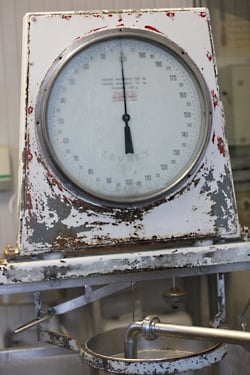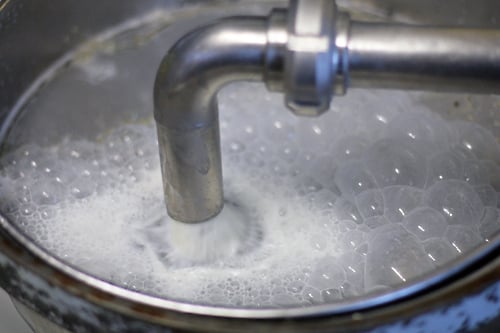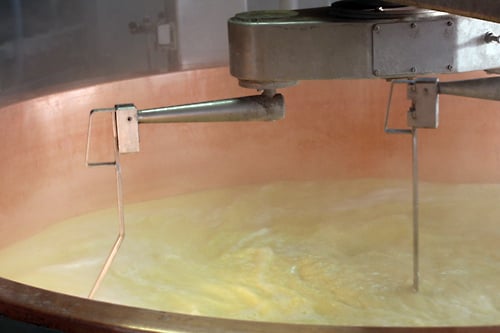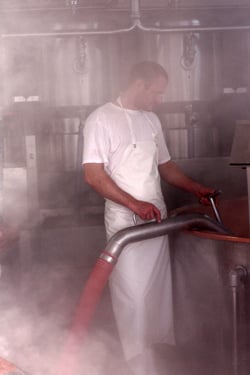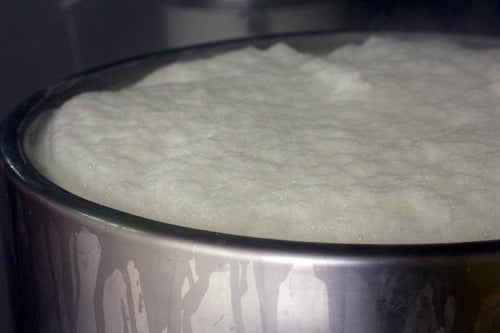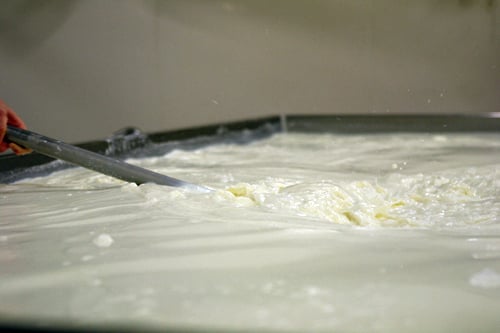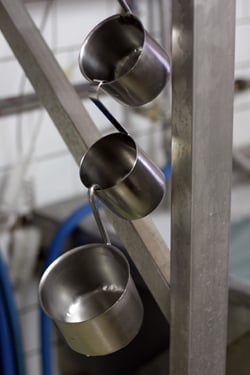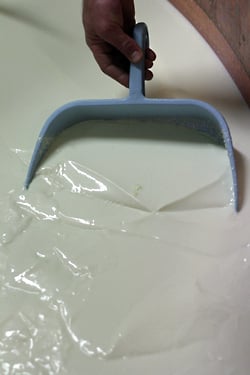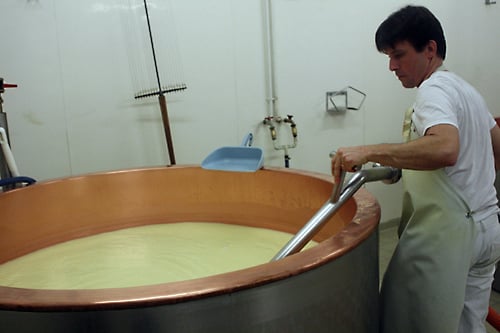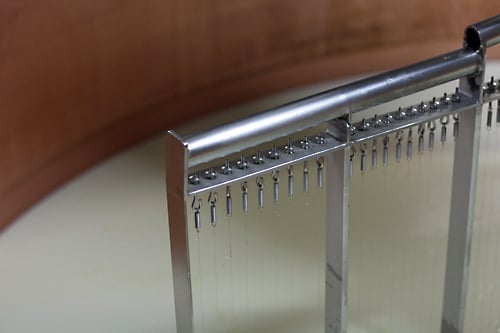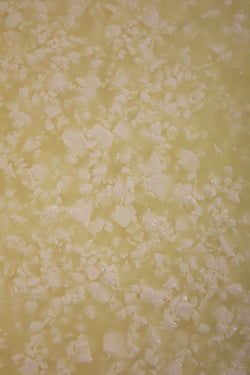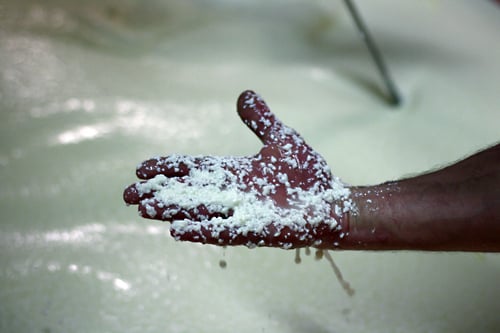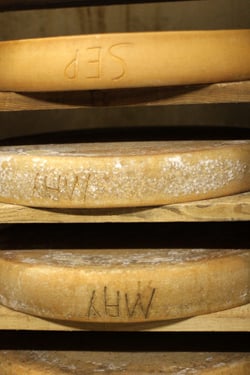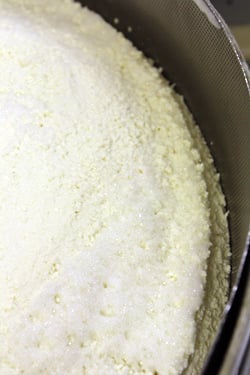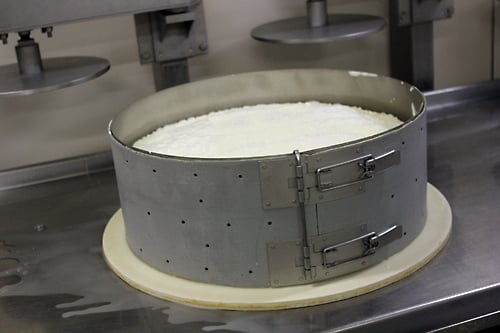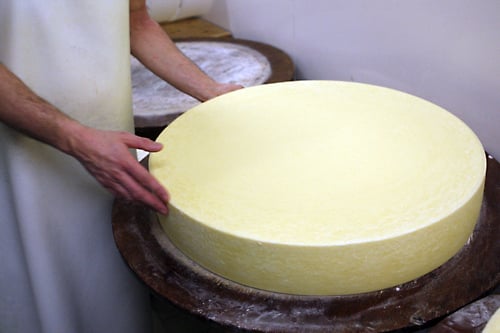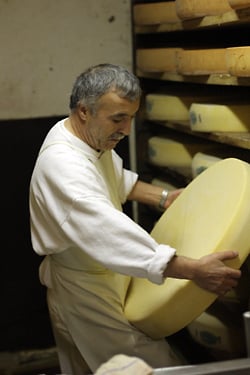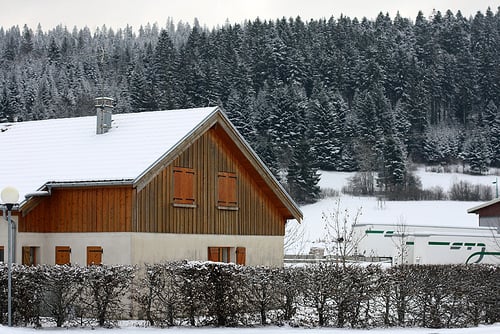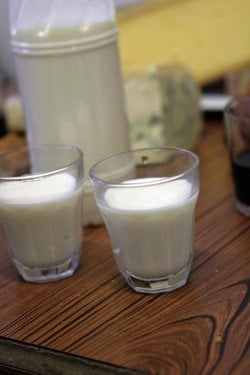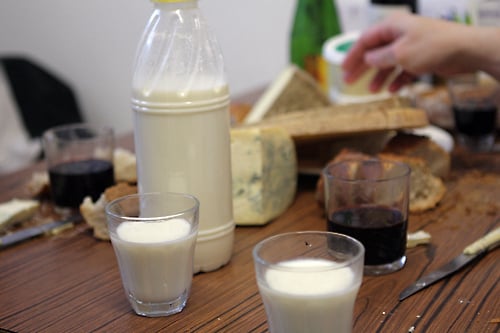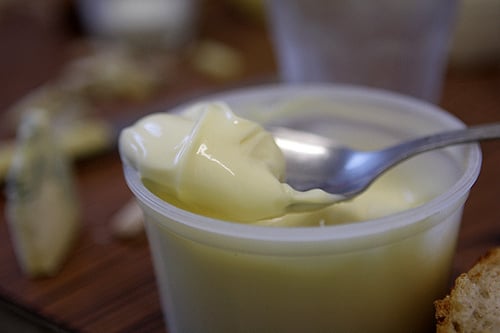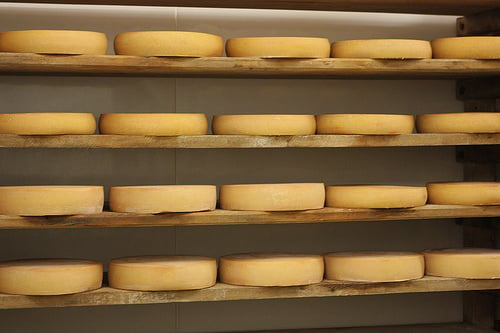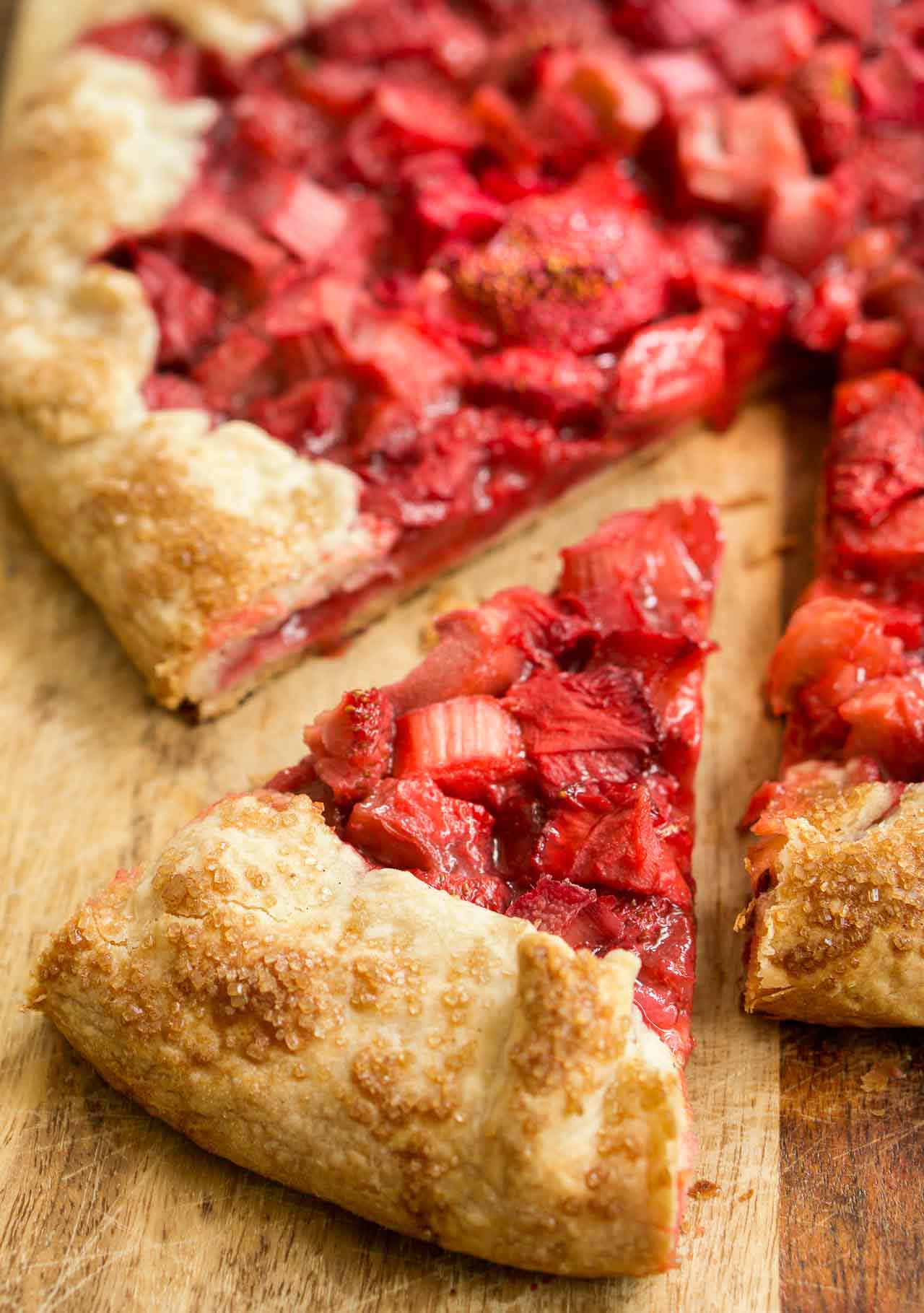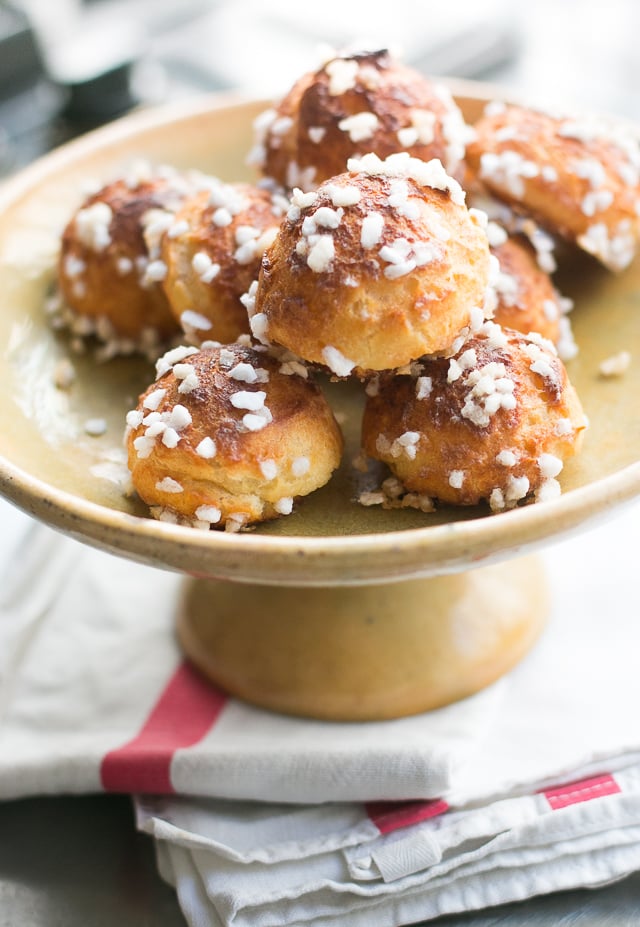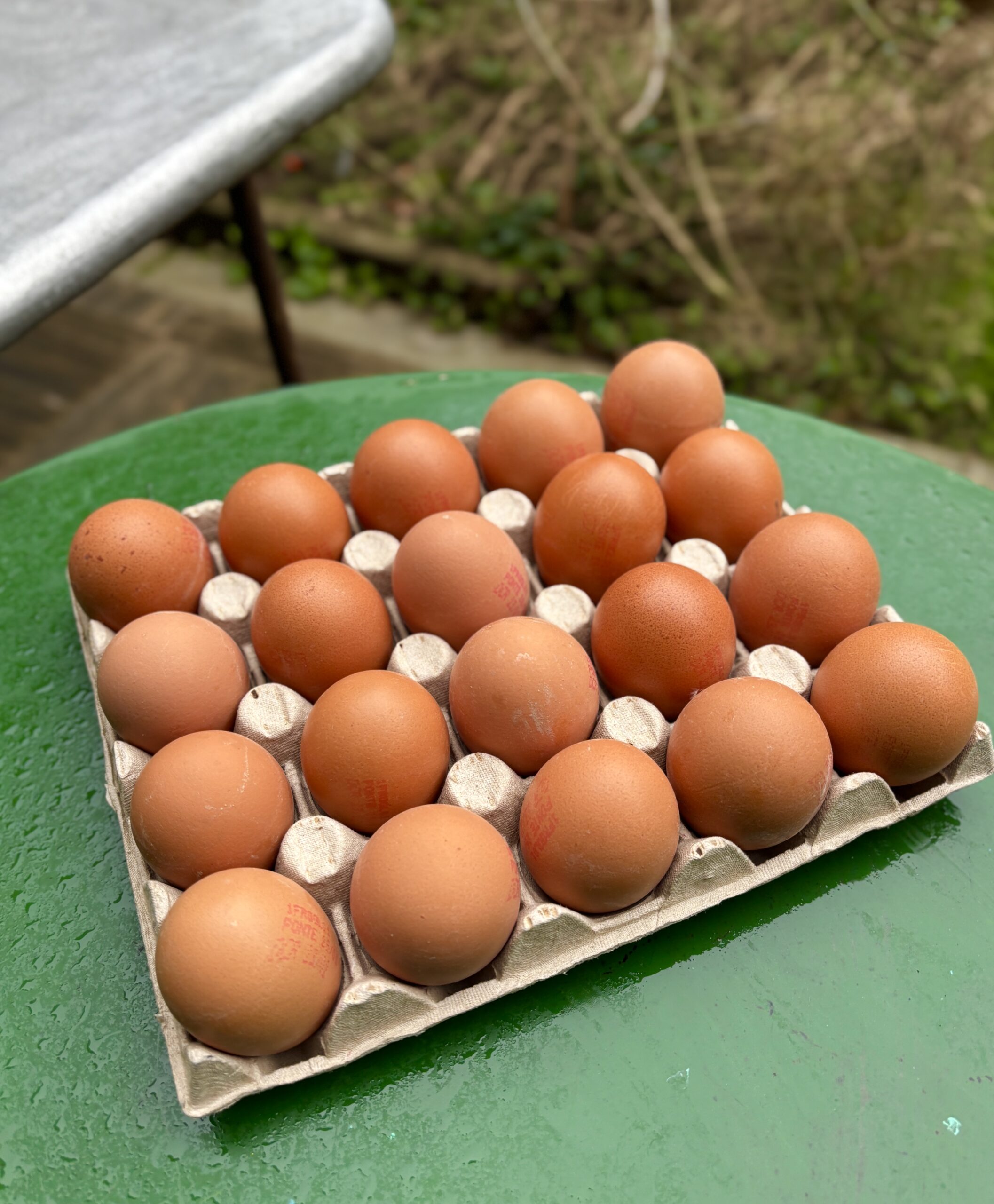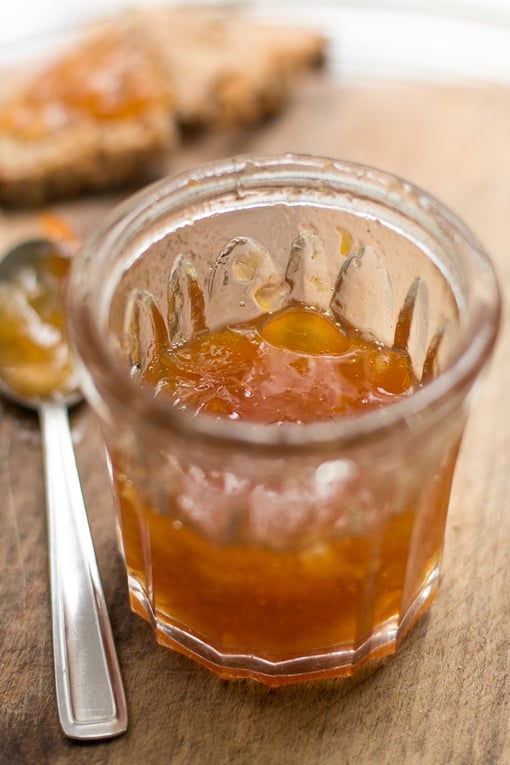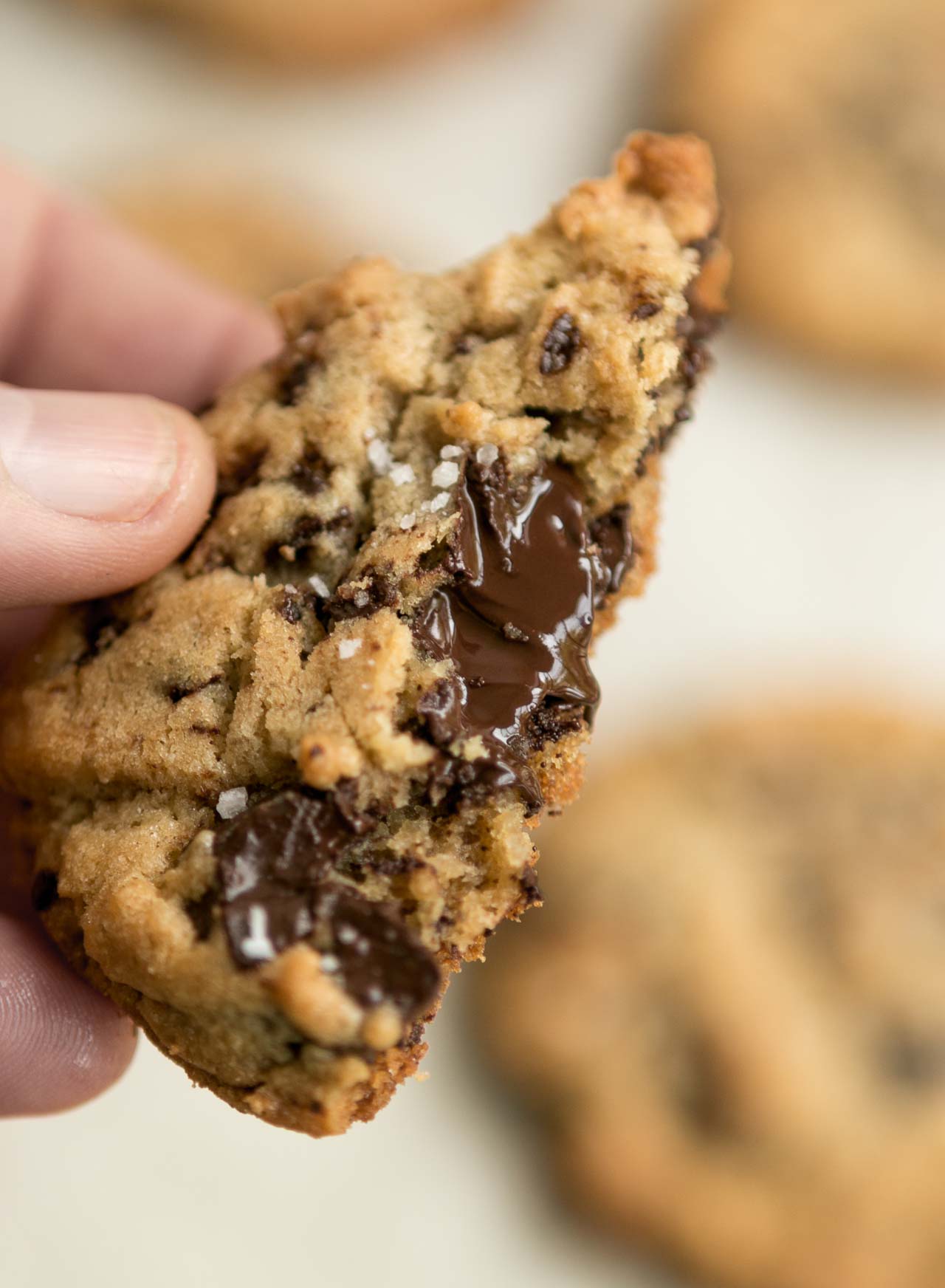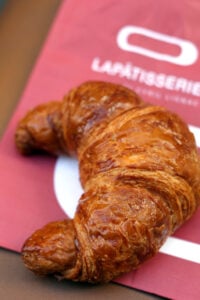Making Comte Cheese
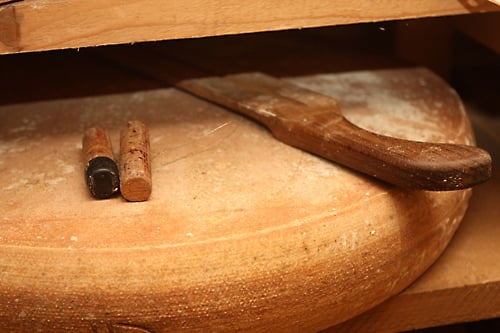
I was recently joking that when I’m forced to wake up very early in the morning I’m not sure if I should feel sorrier for myself, or for the people around me. So when my friend Jean-Louis, who works with the people who make Comté cheese finally gave in to my incessant pestering to join him for a visit, I was excited when after three years, he finally said “Oui”. Actually, he speaks very good English. So he said “Yes”.
But when I got the timetable for our few days in the mountains of the Jura, I didn’t need anyone to translate the fact that I saw that we were going to be getting up very, very early in the morning to watch the cheese making.
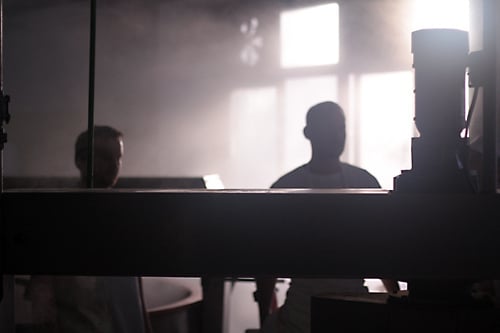
No matter what it is, from candy to cars, I love seeing how something is made. And I will sacrifice a little sleep if necessary. Living in France, the home of hundreds of cheeses, many still made on a relatively small scale, I always will jump at the chance to meet and see the people making them at work. Even if it means prying myself out of a cozy bed in darkness of winter at 4:47am.
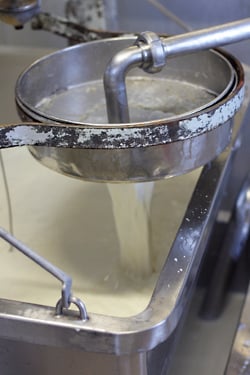
Like a lot of things in French, there are specific words for everything. The cheese production begins, of course, on the ferme where the cows are raised and milked. The milking takes place twice a day on local farms, but since I’ve seen cows being milked, we agreed to meet up when the milk was delivered to the fruitiére.
The word “fruitière” refers to the place where the milk is delivered every day of the year, with no breaks for holidays, including Christmas or New Years. (Which busts another myth that the French don’t work hard.) The word fruitièrecomes from the French verb ‘fructifier‘ which roughly means ‘to produce’ or ‘to bear fruit’.
So the first step in transforming raw milk into cheese, or to get the cheese to ‘bear fruit’, takes place very early in the morning when the still-warm milk is brought to one of the 160 fruitières in the Jura directly by the farmers who’ve milked the cows, where the raw milk is measured and filtered.
All the milk used in the production of Comté cheese comes from within a 25 kilometer (15 mile) radius of the fruitières. It arrives each morning in a large stainless-steel round urn towed by a pickup truck, then is poured into at bin attached to a scale to be weighed. In the past, cow farmers traded milk for cheese since cheese making was originally a way to preserve a bounty of fresh milk for a longer time. Am not sure how it’s done these days, but I am sure a little cheese exchanges hands fairly often between people in the Jura, and everyone seems to win as there’s no shortage of great cheeses in this part of France, enough for everyone to enjoy.
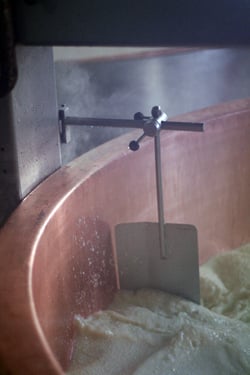
It takes 400 to 450 liters (100 to 120 gallons) of fresh milk to make one 40 kilo (90 pounds) wheel of Comté and the first fruitière we visited only produced two to six rounds of cheese per day. Three people worked there and it was damp and humid, a nice contrast to the rather frosty weather outside. I had to keep wiping down the condensation on my lens, as well as frequently ducking, to avoid being hosed down by the rubber-clad workers who spray everything liberally to sanitize and clean all the surfaces. (I suspected a few were aiming for me, yet I managed to avoid them.)
But except for the La Vache qui Rit factory also located in the Jura, which was allegedly started as a way to use leftover cheeses from the region that weren’t up to snuff and transform it into the bland, but beloved, Laughing Cow processed cheese (and I am busted because I once looked into the kitchen of my local Indian restaurants and found out the secret of their naan fromage was cubes of La Vache qui Rit), there aren’t any giant tanker trucks of milk blasting around the highways of the Jura delivering milk for Comté. This is all artisanal production.
The cheese is produced by a chain-reaction, or as a cooperative; the people who raise the cows provide the milk. The fruitière curdles the milk and presses it into wheels, then the wheels are sent to cool ripening caves in the mountains to age for at least four months. There aren’t any companies that do the whole process from start to finish.
I found the whole thing quite special—in spite of the crazy/early hour, and for those who follow the ‘eat local’ mantra, it doesn’t get any more local than this. Each Montbéliarde cow seems to have a pretty good life and gets one hectaire (2 1/2 acres) of land to freely graze on. The cows are particularly adaptable to the slightly rugged terrain of the mountains and they’re kept indoors in the cold winters, fed a diet of hay rather than the green grass of summer. And the cheese is made within the first 24 hours of milking.
Comté is an AOP cheese, which means that every step of the way that it’s made is protected and must be followed, meaning that the cows must be Montbéliarde, the milk must be raw, and the wood planks used to ripen the disks must be made of untreated local spruce, amongst other things.
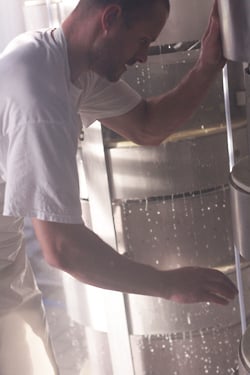
I was fortunate to be able to follow the process over a number of days, from early morning through nightfall. You’ll notice that in the pictures, some of the milk or cheeses are yellower than the others. It may be surprising to those of us who are used to standardized dairy products, but milk isn’t always pure white. And as the milk gets transformed into cheese via culturing and ripening, the milk and the wheels of cheese go through various processes and transformations during the maturation, which not only affect the taste, but the color and texture.
So if you see a Comté that is bright yellow, that’s made from milk produced by cows that graze in the summer months (en été) when they have their choice of hundreds of flowers to munch on. The flowers have carotine which give the milk (and the cheese) a deep, golden color. And some feel it gives the cheeses a better flavor, like Beaufort d’Été, although if you want to get a cheese from summer milk, you’ll need to do a bit of reverse counting when you buy your Comté.
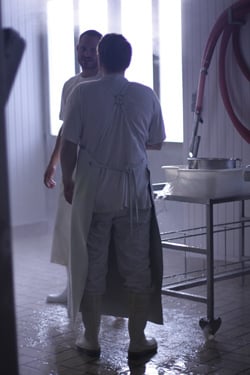
After the raw milk is weighed and filtered, the milk is warmed and rennet (présure) is added, then stirred in. A pot of ‘starter’ is taken from each batch and left in an incubator to add to the next day’s milk. And the one from the previous day is added to the cheese being made right now in the copper vat.
Afterward the milk is left to rest in large copper vats until it forms a giant quivering mass, resembling silky tofu. This step is the caillage, or curdling of the milk, and there’s a pretty wonderful variety of dairy products in France like Caillé that are made this way. Next time you’re in a French fromagerie or crèmerie, peek into some of the earthenware crocks and you’ll often see rustic versions of creamy caillé, a scoopable fresh cheese is meant to be eaten just as is, with a spoon.
Once the milk for the Comté is thick, the curd is broken up by using a device with a series of thin metal strings. The curds are still soft, creamy, and slippery. I’ve seen a fair number of cheeses being made and I’m still always surprised that in just a few months this slippery stuff is going to become a firm and sliceable cheese one day in the near future.
After the cheese curd is cut, it’s stirred further until it forms tight wads whose flavor and texture could best be described as “like rubber”. I tasted one and it wasn’t something you’d want to fill up a bowl and park yourself in front to the tv with. I only ate a tiny bit of a piece that was handed to me, and tossed the rest out.
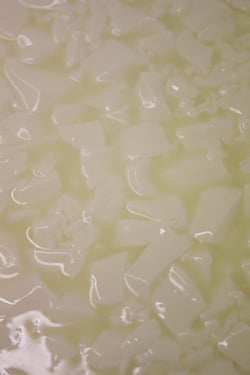
The only way to verify when the curds are the right consistency is by hand. So the expression “lost one’s touch” comes to mind as someone who can no longer tell when the cheese is done by feel. If the curds are left even 30 seconds too long, the cheese will be ruined, so the process at this point must be carefully monitored. And a few times during the morning when I was peering into the copper cauldron, watching them inspect the curds, it seemed like all heck would break loose as immediately they’d all start scrambling to attention to quickly prepare the curds to be deposited into metal molds.
Right away the mixture is strained and the run-off whey is filtered. If you’ve ever seen a cosmetic ad touting lactoserum, those are the milk solids from cheese making in the whey. There’s also a local cheese, similar to ricotta salata, that is made by pressing the milky bits left in the whey that run-off and I would love to find some of that in Paris. (If only I could remember what it’s called*…which is the downside of getting up at the crack of dawn.)
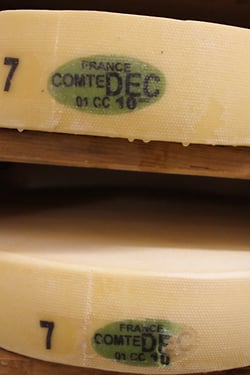
(On a side note, what’s especially interesting is that all cheese basically starts the same way. There are some variables, but basically it’s just milk, and what determines the final flavor is the quality of the milk, the thickness of the pâte, the materials used, and how it’s ripened. That it becomes cheese is just amazing to me, especially when I see the process involved.)
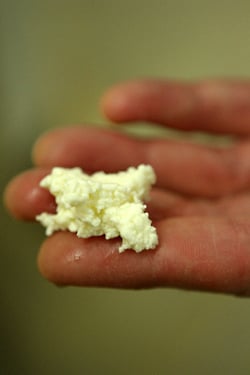
Large metal molds are filled with the curds then pressed by machine for 24 hours to get the excess liquid out and to compact the curds.
When turned out a day later, the rounds are large rubbery disks that can be flexed and bended. The fellow unmolding these cheeses lifted one up, using the strength of his substantial forearms, he shook it wildly up and down to demonstrate how flexible and bouncy it was. Each round is incredibly heavy and it was surprising at how matter-of-factly everyone at the fruitière (and the ripening caves we visited later) were able to handle the giant disks with seemingly no problems. I’d be moaning and groaning all day. But on the other hand, I’d have amazing arms. So I guess it’s a fair trade off.
Before the cheeses hit the wooden shelves of the ripening caves, each wheel is washed and rubbed with a mixture of yeast and water, then scrubbed with coarse sea salt from the Guérande, the only non-local ingredient in the process. (The Jura is the region in France that’s one of the farthest from the ocean and the only salt nearby is mined and too harsh.) They told me even the rennet was made from the stomach lining of local calves and showed me a twisted sheet of the stuff, which was like crinkly parchment paper.
The cheeses are left to being their ripening before being shipped to cool caves high up in the mountains to finish the affinage.
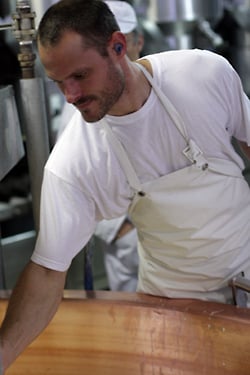
But the cheeses need to be kept at the fruitière until firm enough to move and this one gentleman had a few decades on me and wasn’t having any problems lifting and flipping the cheeses all by himself. Obviously he’d mastered the right movements to properly balance and flip les meules using his knee and legs, rather than his back.

During my time in the Jura, I was constantly surprised whenever I was talking to someone about a cheese and in mid-sentence, they’d deftly slip the wooden cheese-lifter (and shown in the photo at the start of the post) under a disk of Comté and flip it up just as easily as if they were flipping over a pancake.
When they crew is done with their early morning work, they sit down for a well-deserved breakfast, French-style. When I was in cooking school in France, at 10am the chef would stop the class and bring out a tray of Aligoté white wine and we’d all take a pause for a kir. Ever since then, I’m not all that surprised when being offered a glass of wine in France at an hour that one might not normally consider prudent. But I opted for a cup of dark coffee instead.

But also, I couldn’t resist a glass of raw milk from the local dairy that’s used in the cheese making as well. I don’t drink a lot of milk, most of the stuff goes into my morning café au lait (or ice cream), but this was really tasty and I could see why the cheese tasted so good.
Curiously, when I posted a quick snap of the breakfast from my smartphone on Twitter, a response came back expressing dismay about the tableau. I wasn’t sure what that meant because this was such a wonderful and special little moment: we were up here in the mountains with people sitting down to a meal of crusty bread from the boulangerie across the way, whose fogged up windows we passed on our way to the fruitière earlier that morning. There was a bottle of the local vin du Jura to wash down coarsely-cut hunks of the cheese that they’d made themselves, and were enjoying the fruits of their labor and seemed to be content.
It was one of those moments that I have in France from time to time, and that happen a lot in the French countryside, where life is decidedly different than in the city. And when I find myself in these situations, I think to myself about how special it is to be sitting here, up near the base of the alps, passing around bread and wine with the cheese makers who likely don’t feel as if they’re doing anything special, it’s just their life. When in fact, what they’re doing is pretty special, I think.
Yes, it was still pretty early and maybe it was the coffee that was starting to kick in, but made me really happy to be sitting at the rickety formica table with the people who make these cheeses day in and day out. And you’d think the last thing that people who spent their whole day curdling milk and lifting wheels of cheese all day would want for breakfast would be more cheese. But here they were, lopping off enormous hunks of Comté and Bleu de Gex, along with thick slices of sausages, and eating them all with gusto.
Since nothing gets wasted here, I discovered a new cheese byproduct, called Cancoillotte, a local spread made from the milk solids recuperated during the cheese making process.
Once called the cheese of the poor, this thick, creamy spread is now something of a local novelty, so much so that what was once considered the “cheese of the poor” was served to us after dinner at a fairly swank restaurant a few days later. But here, it tasted much better.
Part 2: Ripening and Tasting Comté, and (almost) meeting my maker…
Notes
These photos were taken at two fruitières in the Jura: Fromagerie de l’Abbaye (in Chézery), and the Fromagerie de Frasne (2, rue de Bellevue, Frasne, Tél: 03 81 49 82 26).
Both cheese making facilities aren’t normally open to the public but they do have excellent shops attached to them where you can purchase their cheeses and other local products. You can find a list of facilities which offer tours at Les Routes du Comté.
*Jean-Louis notified me the cheese that’s similar to ricotta salata is Le Serra, which I’ve not seen anywhere else.
Related Links and Posts
Making Morbier and Comté (The Cheesist)
Making Irish Coffee at Ardrahan Cheese
Comté (Official Website)
